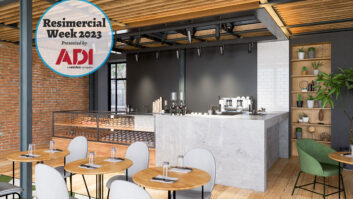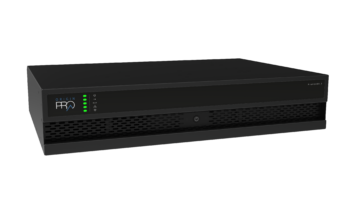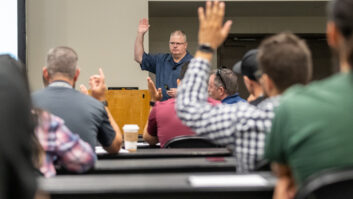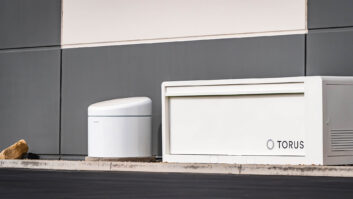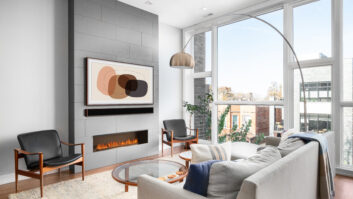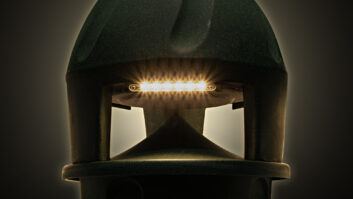Drew Balsman has recognized two key differences between residential and commercial AV integration. One occurs on the planning stage and the other involves spending extra time on R&D. “With residential it’s easier to go back and change your mind, but on commercial, it’s pretty much the way you bid it,” said the co-owner of HD Media Systems in Cape Girardeau, MO.

This executive boardroom, installed by HD Media Systems, houses an airplane wing that has been powder coated orange and a glass top added to make it a truly unique table. The boardroom features a 60-inch Samsung LED flush mounted in the wall. Vantage lighting control helps highlight the table and LED fixture in the room. Sonance speakers in the room provide audio when needed, and Polycomm supplies a wireless phone for conference calls.
In many ways, the commercial crossover “trend” seems to have turned into the norm for any firm looking to survive in the challenges that today’s market presents for home technology. RS hit the trenches to hear some stories from dealers that have worked on varying levels of the “crossover” scale.
In discussing some of the unique challenges of commercial installations, common themes recurred regarding the scheduling of projects, targeting bids to a broader group, working effectively with IT managers, as well as the understanding the scale and logistics of larger commercial projects.
The Schedule’s the Thing
“In light commercial, it is even more key to stay on top of the schedule,” said Jeff Rodgers, owner of Metropolitan Music and Cinema in Indianapolis. “When it is time to do your part, it is imperative that you get it done on time and when scheduled. In resi construction, you generally have a few days to make sure you meet the schedule.”
Sticking to a stricter schedule was also noted by Dan Hirschberg, owner of Homedia Electronics, of Ringwood, NJ, as well as coordinating schedules with other trades that might be on site. “We have learned to work more efficiently and to work with the other trades to meet deadlines,” he said.

This multipurpose auditorium, installed by HD Media Systems, features a motorized Vutec 220-inch screen and a DPI dvision 30 projector with 24 Sonance in-ceiling speakers and four twelve-inch subwoofers. The room also features an in-wall ipad for control and a Savant media dock for streaming content to the room. Savant also controls all of the Vantage lighting. RGB LED lighting that can be changed from the iPad highlights a large bar and seating area in the back of the space.
Hansson, credits the meticulous presentations and designs Logic Integration creates for some of the firm’s success. Logic Integration represents various brands, including Runco, SpeakerCraft, Chief, and Stewart Filmscreen, among others.
According to Jonathan Wright, owner of Elite Controls in the San Francisco Bay area, scheduling is a challenge that involves balancing with the client’s business hours. “We often schedule installations to start at the end of business hours to accommodate our clients and their customers as well.”
A critical part of scheduling for Shawn Hansson, CEO and founder of Logic Integration of Lone Tree, CO, is the detailed planning involved prior to the actual installation. “We’ve learned and seen from other companies that the scope of work, system design, and layout up front is really important and really creates the roadmap to come.” He noted that with residential projects, this could be a lot looser.
The Who’s Who
The people you work with can often make or break the success or fulfillment of any job, and there is a whole range of different people involved with a commercial installation.

HD Media Systems owners Scott Starzinger (left) and Drew Balsman (right).
Hansson, credits the meticulous presentations and designs Logic Integration creates for some of the firm’s success. Logic Integration represents various brands, including Runco, SpeakerCraft, Chief, and Stewart Filmscreen, among others.
In residential settings, designers, engineers, and homeowners may all be involved with the project. “Although it is important to keep everyone happy, the homeowner is the end user of the system, and therefore, should be the priority,” Wright said. “In contrast, commercial jobs tend to include the wants or needs of many different personnel, such as the CFO, CEO, general manager, IT, and consultants. The challenge is installing a system that will best suit the needs of a business as a whole while taking everyone’s opinions into consideration.”
Here again, Wright noted the importance of keeping accurate documentation. “Keeping everyone informed on the schedule, what’s expected for the job, and updating any changes to the system is ideal for productivity.”
Other parties that you might cross paths with on a commercial install include landlords, building managers, property associations, multiple general contractors, local unions, as well as a job foreman.
“It is key to establish a good relationship to the job foreman and building super,” Rodgers recommended. “You need to have access to the riser rooms for data home runs, and it is usually kept locked.”

This wine store installation by Logic Integration highlights one of the more innovative applications of AV in a retail environment.
Rodgers also noted that attending project update meetings might be necessary depending on the scale of the project.
Coordinating with IT departments is also very important. “IT folks get grouchy when we tell them we have to be on the network,” Hansson said.
One way that Hansson works with IT is by coming up with whitepaper-like descriptions of what Logic Integration needs for its control system to function properly; working almost exclusively with Crestron controls streamlines this process for the Colorado firm.
Balsman, whose brands include Digital Projection Inc. and many others, said that working with the internal IT staff at a commercial facility could be a challenge. One way to avoid “stepping on anyone’s toes,” he said, is by “making sure we balance what we’re doing with what the IT guys are capable of handling.”

Logic Integration made the decision to transition to more commercial projects a few years ago. Here is a plastic surgery doctor’s office where the firm integrated AV gear.
Balsman has a big advantage with the IT crew because his business partner comes from an IT background, which he said provides credibility for his company. IT people “are protective of their network if AV guys are coming in,” he said. “When you can speak their language and relate, it definitely makes it easier.”
Size Matters
Perhaps more than any other challenge that a commercial installation presents is the simple scale and resulting logistics that differ from the typical residential project. Aside from more products spanning more zones capable of more muscle, there’s added logistical complexity to consider. This may include working with metal studs and conduit, opposed to 2×4 walls. “You need special drill bits, and you generally use conduit for each drop,” Rodgers noted. “Also with the metal studs come more chances to slice your hands up.”
Rodgers also recommended inquiring about plenum-rated ceilings during the bidding process because special types of wire are required to be up to code. You can also request very detailed prints to indicate where wall plates are located, he said.
“Keeping up to date with all local and state laws is a must,” according to Wright, noting the many code differences between residential and commercial jobs that affect everything “down to the type of zip ties we use.”

This control interface designed by Cliqk allows shoppers to change the music or lighting in their respective dressing rooms in New York’s C. Wonder boutique.
The logistical challenges often vary depending on the type and location of a job. Most of Hirschberg’s commercial jobs happen to be in New York City, where parking is a huge inconvenience, with restrictions and the drawbacks of metered parking. “It may sound insignificant, but being able to go back to the truck for parts is sometimes essential to a portion of the job,” he said.
Renting lifts and keeping up on OSHA certification are other examples of logistical considerations.
Other Challenges
Several dealers mentioned specific technology areas that present different challenges for commercial installs, including access control, integrating with third-party control software and getting all products to work together with it, telecommunications, implementing fiber, knowing what kind of cable to run, as well as differing connectors and touchpanels. The influence of the iPad comes into play with touchscreens, which could often be confusing and complicated. Hansson said integrating iPads in commercial projects can be a problem solver for company executives that are more familiar with the Apple interface.
Balsman also cited the iPad as an example of “some residential technology transcending into the commercial space because the residential [technology] works so seamlessly.”
Sales methodology differs from residential as well. “I have to be willing to compromise equipment profit to land these jobs,” Hirschberg conceded. “Our commercial jobs are mostly restaurants, and the AV is usually not as important as some of the other components to it. So my clients’ budgets are more geared to the décor and food service equipment,” which he, added, is understandable.
As far as helpful tools go, most manufacturers and distributors are a great resource. Rodgers and Wright, both AVAD dealers, touted the distributor’s tech support and design centers.
Hybrid Future
While crossing over into commercial installations started out as an industry trend primarily in response to the shrinking residential AV channel, perhaps it is appropriate to revise this view to more of a status quo in recent months.
In Balsman’s experience, commercial installation bidding really picked up about year ago, and he believes they will start targeting the commercial market more aggressively. For instance, his company is trying to figure out how to target banks, schools, and other places with boardrooms, he said. HD Media Systems also has hired an outside sales rep dedicated to commercial sales.
Logic Integration “changed over hard” to the commercial market about three years ago, Hansson said, citing a new website, marketing, retraining on new products and brands, getting certified, and hiring new employees experienced with commercial installs. “We went really extreme with it,” he said, and it seems to have paid off for the firm, which was recently awarded the contract for converting a former underground missile silo into luxury, apartments for so-called “dooms day preppers.”

This office has a full blow Vantage lighting system, Samsung LED 55-inch TV in the corner, and Sonance in-ceiling speakers. The office also features Lutron motorized shades for privacy and added temperature control. The entire office complex is controlled by iPads via Savant Automation. This installation was completed by HD Media Systems.
An example of where the future of the industry may be headed, is a young technology design firm, called Cliqk, which started out eight years ago installing high-end residential systems. After shifting its focus a few years back to take on some retail and hospitality installations, owner Mark Hernandez says commercial jobs now make up twothirds of his company’s business and that number is growing rapidly. Hernandez said that Cliqk has transitioned into what he calls a “technology design consultancy” or “technology architects.”
Part of this transformation was the design-heavy background Hernandez and his team has, but he said, “We leveraged our expertise in the residential sphere to apply in a retail environment.”
One of Cliqk’s most successful jobs, the trendy C. Wonder boutique in Manhattan’s SoHo district, features an interactive dressing room interface that allows shoppers to change the music or lighting in each individual room. Consumers have come to know the C. Wonder brand for this novel technology feature, and it has become a key part of the brand, Hernandez said. C. Wonder is planning to expand, with six to 10 more retail locations scheduled for this year, and Cliqk is basically tied to the brand now.
The firm experienced similar success with Dr. Dre’s Beats retail location, the first of which was planned as a seasonal popup store in Manhattan that is now permanent, and there are several other locations worldwide in the works, with Cliqk as the go-to source for AV.
Cliqk offers a great example of how a residential ESC has capitalized on its strengths to great success in the commercial market. Although Hernandez admitted that moving away from residential jobs is “a natural evolution for us,” his experience epitomizes the type of innovation the residential channel has been known for historically and has led to its highest points of success.
Lindsey Adler is associate editor for Residential Systems and Systems Contractor News.
